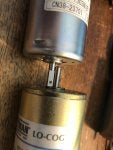Again, best bang for the buck until the half off Lionel sale is this motor IMO.
Find many great new & used options and get the best deals for Pittman 9234E454 12VDC 500 CPR Precision Motor - NEW at the best online prices at eBay! Free shipping for many products!
www.ebay.com
There are a couple of sellers as well with this exact model
Pittman 9234E454 12VDC 500 CPR Precision Motor
View attachment 565633
Key features (some of this is my opinion but tried to show why I think that)
#1 Best brush holder design with shunt wire brushes in a plastic guide holder that is replaceable and compatible with previous Pittman brush assemblies.
#2 12V rating
#3 dual shaft if you need it for a specific locomotive install or cut off if you don't need it.
#4 same basic size as 9434 (40mm dia x61mm long) once the encoder portion is cut off.
#5 dual ball bearings
Again, this motor is part for part compatible with the 9434 series and even if you only swap the brush assembly, at $20, heck, good for parts for other motors.
My sequence is, first I remove the encoder cover (2 screws) then use an allen key bit set to remove the setscrew and the encoder disk from the shaft along with the encoder sensor.
I then use hot glue around the motor shaft to seal the ball bearing from contamination during the cutting process.
A portable metal bandsaw and a vise, I cut off the end of the encoder housing right at the visible parting line in the casting.
I then dress up the edges using a file or a Dremel tool.
With a drop of rubbing alcohol on the edge of the hot glue causes it to break free from the metal. It only takes a drop.
Last, yes, this is longer than the Canon motors. Also the shaft is shorter.
Canon motor is 38mm dia, 55.3mm long, Shaft is basically 14.5mm from the front lip of the bearing
Pittman motors are 40mm dia, 61mm long, 13mm long
Note, the black dot shows exactly where the flywheel setscrew lands on the Canon motor shaft. This in turn barely and I do mean barely hits the end of the 13MM Pitman shaft when installed.
View attachment 565635
One last note, the original screws used with the Canon motors do not fit the Pittman, they are too small diameter and do not hold. I slightly drilled the motor mount and the plastic flywheel guard to use these
Machine Screws, Flat Head, Phillips Drive, #6-32 X 3/8 in, Grade 18-8 Stainless Steel
I chuck them up in a drill (AKA the poor man's lathe) and slightly shave the face of the head while spinning to thin them for clearance and also slightly shave the outer rim of the head diameter. This matches the smaller Canon screws and allows for the encoder ring clearance.








